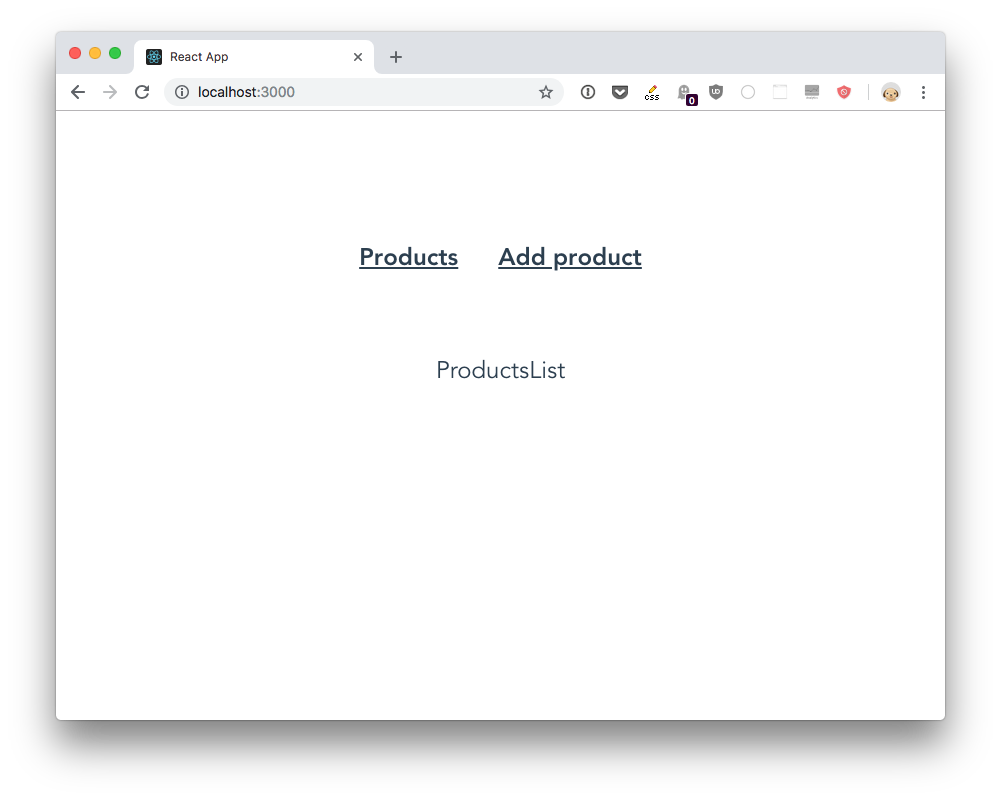Now that we have a common base whether you use the create-react-app locally or CodeSandbox, we can start building our app.
Given the premise of the introduction, we’ll start with 3 components: AddProduct, ProductsList and SingleProduct, which will provide
- the add product form
- the products list
- the single product view
Those components will all be added to the navigation on top of the page, along with “Home” and “About”.
Let’s start by adding them, with a minimal boilerplate to just see them working as part of the router:
Create src/components folder and add
src/components/AddProduct.js
import React from 'react'
export default () => {
return <div>AddProduct</div>
}
src/components/SingleProduct.js
import React from 'react'
export default () => {
return <div>SingleProduct</div>
}
src/components/ProductsList.js
import React from 'react'
export default () => {
return <div>ProductsList</div>
}
Next, open App.js.
First we need to import React router:
import { BrowserRouter as Router, Link, Route } from 'react-router-dom'
Then we import the components we just created:
import AddProduct from './components/AddProduct.js'
import ProductsList from './components/ProductsList.js'
import SingleProduct from './components/SingleProduct.js'
Now we can use this React Router basic structure:
const App = () => {
return (
<Router>
<div>
<aside>
<Link to={`/`}>Products</Link>
<Link to={`/add-product`}>Add product</Link>
</aside>
<main>
<Route exact path="/" component={ProductsList} />
<Route
path="/add-product"
component={AddProduct}
/>
<Route path="/product/:slug" component={SingleProduct} />
</main>
</div>
</Router>
)
}
Notice how we add a specific path to each component, and the Product component accepts a dynamic path /product/:slug. There will be multiple pages on the site that match the Product component, one for each different product.
Now replace the src/App.css content with this:
input,
textarea {
border: 1px solid #ccc;
padding: 20px;
vertical-align: middle;
}
label {
vertical-align: middle;
padding-right: 10px;
}
div {
display: block;
padding: 50px;
font-size: 1.5rem;
}
.button {
background-color: #2c3e50;
color: white;
font-size: 1.5rem;
width: 50%;
}
#app {
font-family: 'Avenir', Helvetica, Arial, sans-serif;
-webkit-font-smoothing: antialiased;
-moz-osx-font-smoothing: grayscale;
text-align: center;
color: #2c3e50;
}
aside {
padding: 30px;
}
aside a {
font-weight: bold;
color: #2c3e50;
padding: 20px;
}
aside a.router-link-exact-active {
color: #42b983;
}
You don’t need to understand it if you are not a CSS expert, but it should just give the app a better look.
The final result should be this:

And you should be able to see the AddProduct screen when you click the link.